When it comes to self-defense, carrying a sidearm is only half the battle.
What’s the other part?
Training.
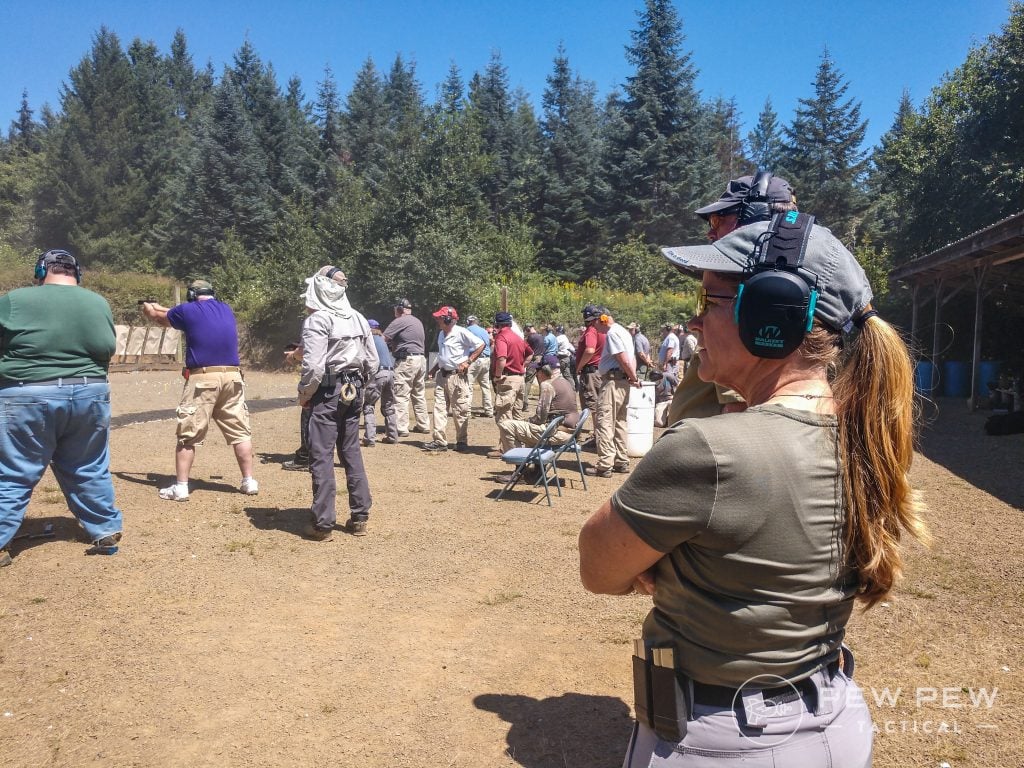
Knowing when and how to use your gun and developing the muscle memory to do it smoothly are essential components to the self-defense mindset.
Think of it like eating healthy and exercising…
People know they should do it, but it’s easier not to. However, when something bad happens, you instantly know where you should have put your efforts.
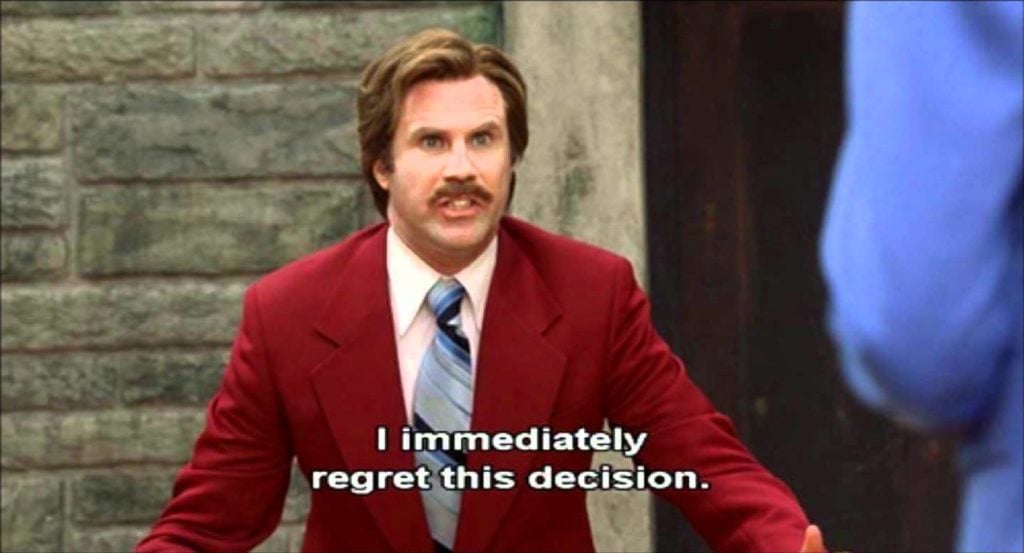
So with that in mind, we’ve gathered some tips on perfecting that CCW draw.
At the end of the day, this article is not a replacement for quality training but rather serves as encouragement to get out there and do it!
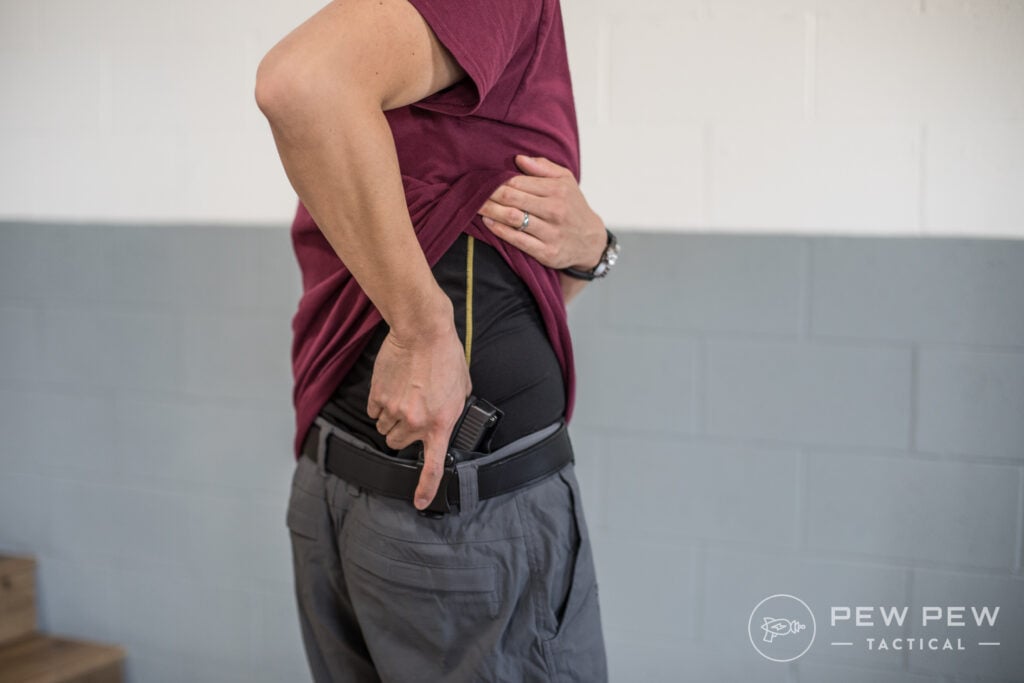
The tips below may seem a little on the basic side, but they are fundamental to being a responsible gun owner.
Training is essential, people.
Table of Contents
Loading…
Why Practice Drawing Your Gun?
Ok, so like we’re busy adults with too many distractions vying for our attention. Why should gun training and, specifically, draw practice earn a spot in your busy day?

Quite simply, practice makes perfect. I know, I know, it’s cliche, but it’s true.
The more you practice your draw, the better you’ll get.
Movements will smooth out, things will speed up, it all works up to a better overall experience. Not to mention, the more you practice, the more confident you feel in your abilities.
And all that practice gives you the benefit of knowing what outfits work for CCW and how they move as you move.
You don’t have to invest hours into drawing drills, either!
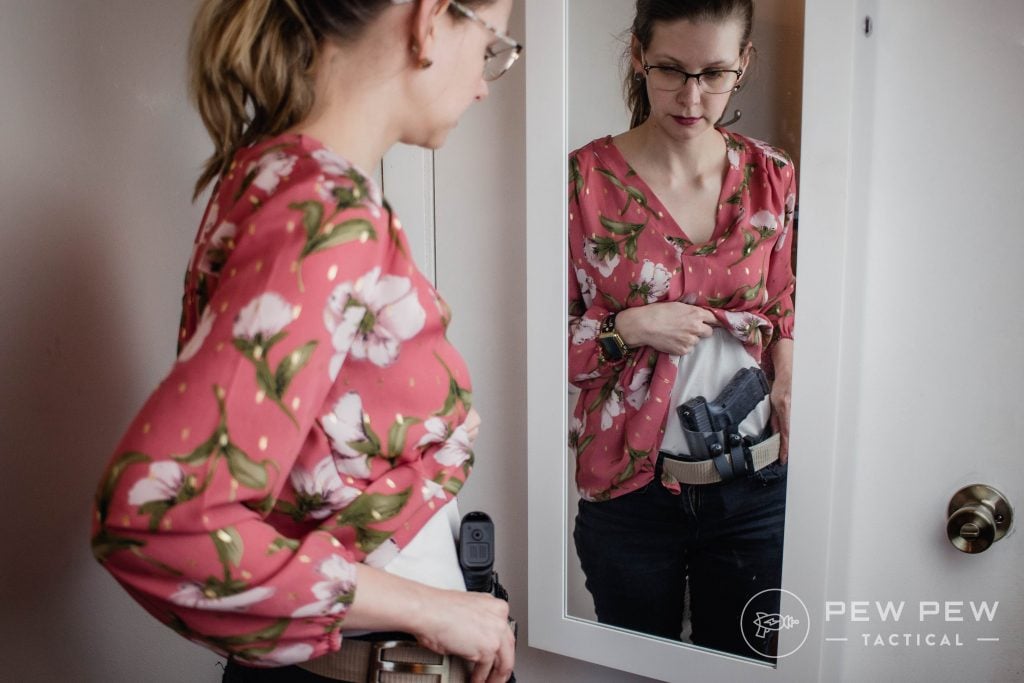
A few minutes a day at home running dryfire drills coupled with some range time when you can afford it goes a long way.
Check out our comprehensive guide on Dryfire Training at Home!
Where Can I Practice Drawing from Concealment?
The easiest, cheapest, and most convenient place to get practicing is at home. With the tools mentioned above, you can start now!
Of course, dryfire is no supplement for the real deal, so if you can, range time only improves your skills.
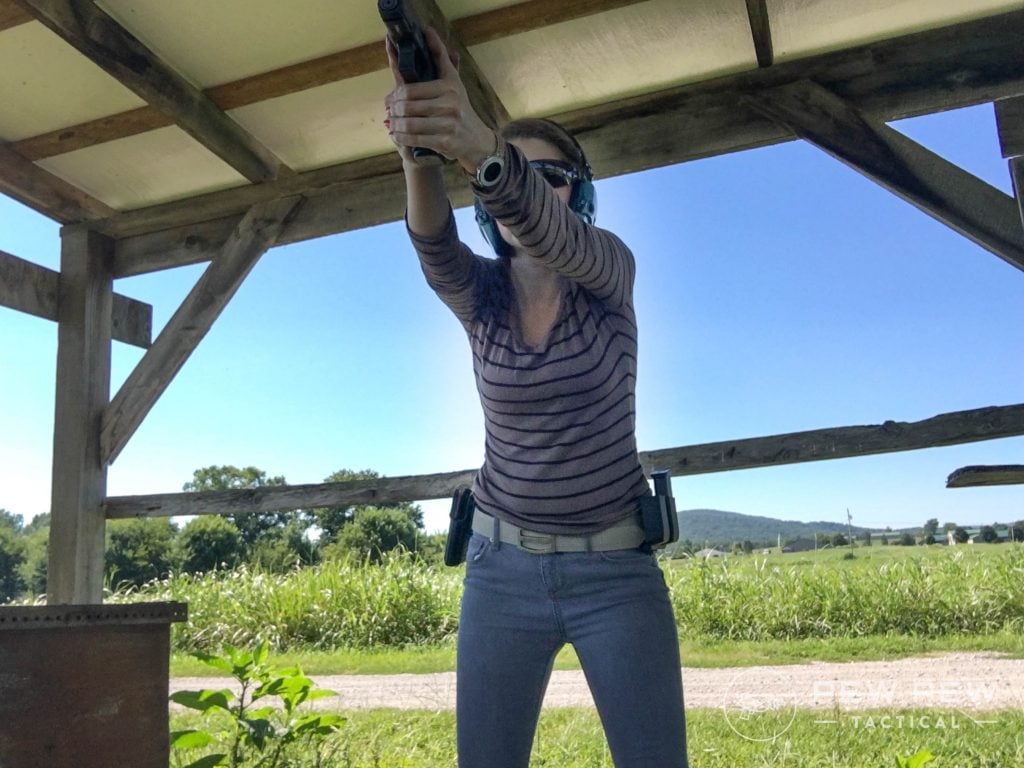
But first, you need to ask if your range allows drawing from concealment.
Some have to issue with it, while others prohibit it. Still, some allow certain kinds of drawing but not others.
Best practice is just asking what is acceptable and following the rules (or finding another range that allows it).
What Tools Do I Need To Practice My Draw?
Luckily, the list of things you need is pretty short.
- Gun or Training Gun
- Holster
- Belt
- Spare Mag (if you carry an extra)
- Snap Caps (if indoors)
- Ammo (if on the range)
You need your gun or a training gun, holster, and belt you use for concealed carry to start. If you carry or plan to carry a spare mag on you, you’ll want to have this handy as well.
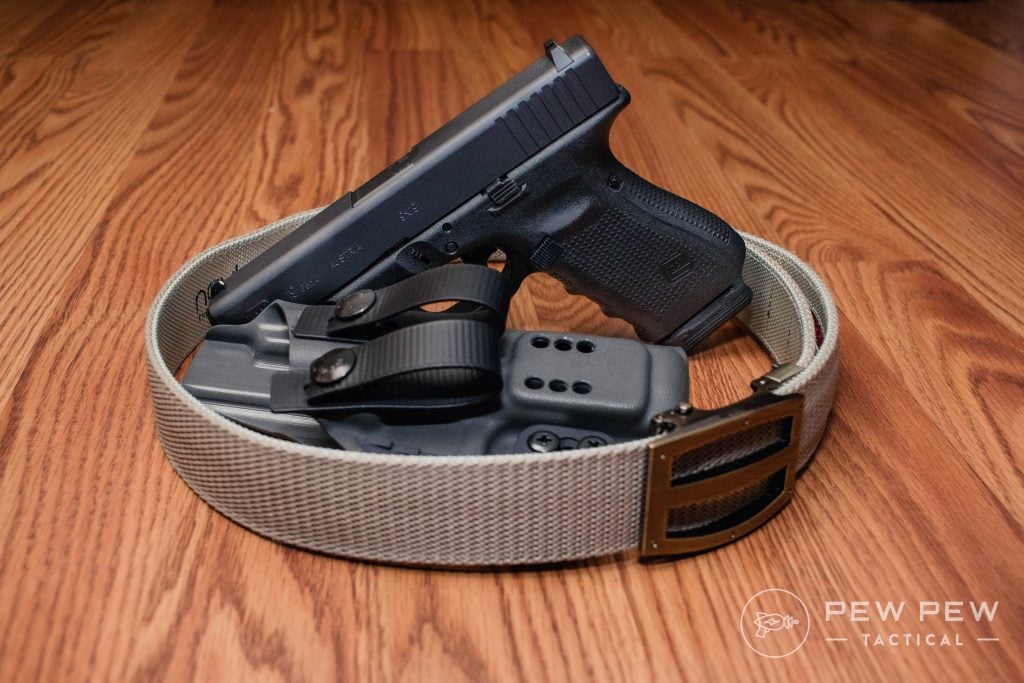
Snap caps, or dummy rounds, are also great to have on hand and serve a few purposes. Some gun models can be damaged by repeated dry firing, so snap caps keep certain guns safe.
These artificial rounds also allow you to practice manipulations like slide racks and trigger pulls safely.
And bonus, you can even work on malfunction drills!
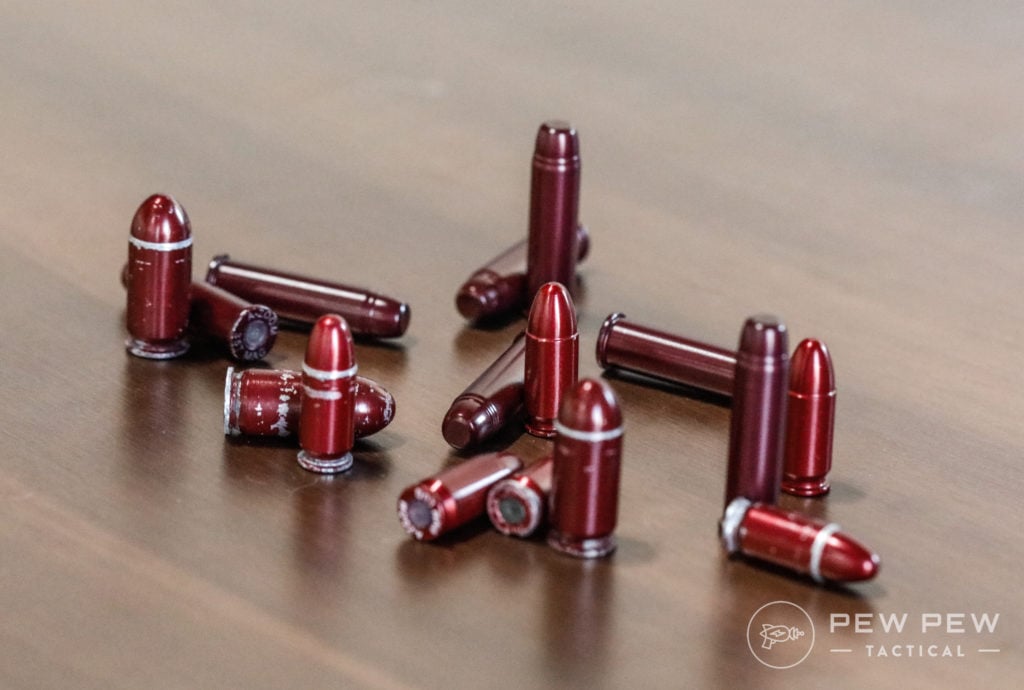
To really amp up your training, you can also incorporate laser training cartridges or guns.
These devices aren’t necessary but can really step up your dryfire training — especially when ammo or budgets prevent you from hitting the range often.
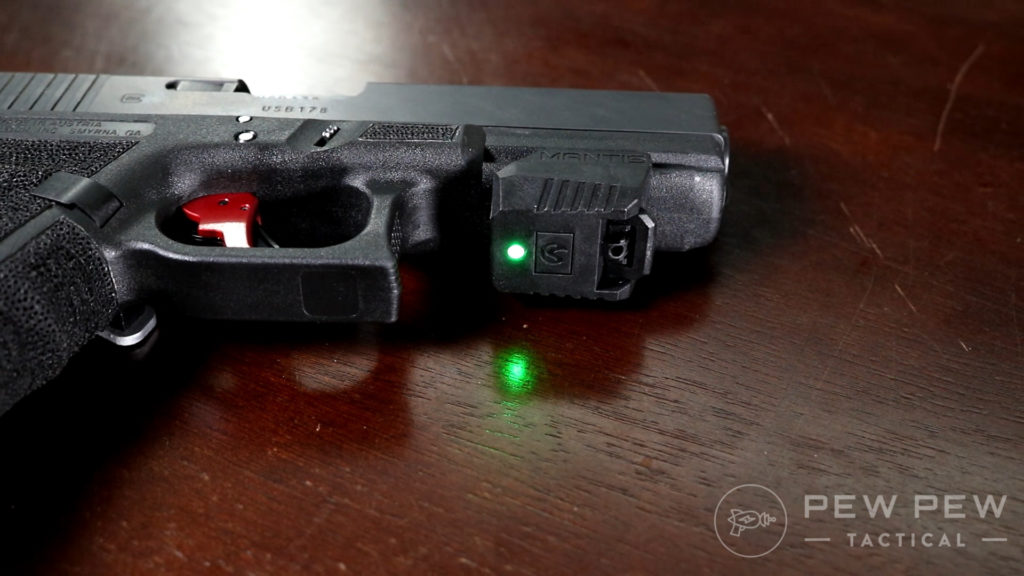
A quick note about working on CCW draws indoors: Be sure to REMOVE ALL AMMO from the gun and set it aside.
Preferably, store it in a completely different area than the location you’re training. It’s easy for snap caps and ammo to get mixed up on a table, and you definitely don’t want to make that mistake.
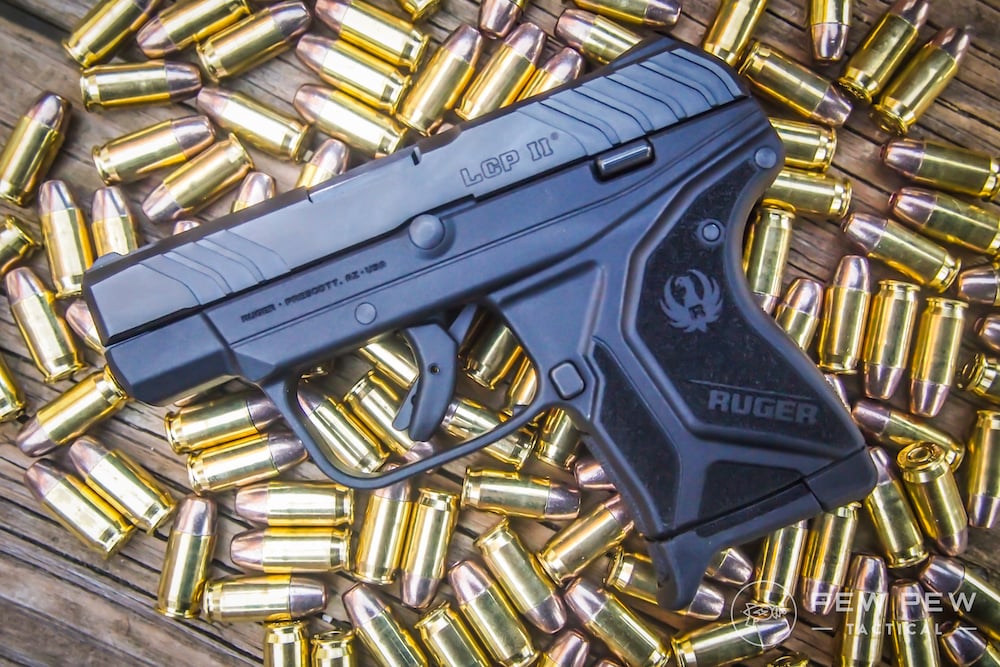
How To Draw from a Concealed Carry Holster: IWB & OWB
So, there are many different ways to carry a gun on the body: Strong Side (IWB/OWB), AIWB, Ankle, Pocket, Shoulder, etc.
We don’t have enough space to go into ALL of those concepts. (But you can click each one to go straight to a PPT article dedicated to them.)
To simplify the process, we’re sticking to the two main ways most gun owners carry — IWB and OWB.
Drawing from an OWB Holster
Because an OWB holster sits on the outside of the pants, it’s often a bit easier to get to than the standard IWB.
In most cases, you’ll be dealing with an overshirt, jacket, or vest. Though, you can wear sweatshirts and less form-fitting shirts and still OWB.
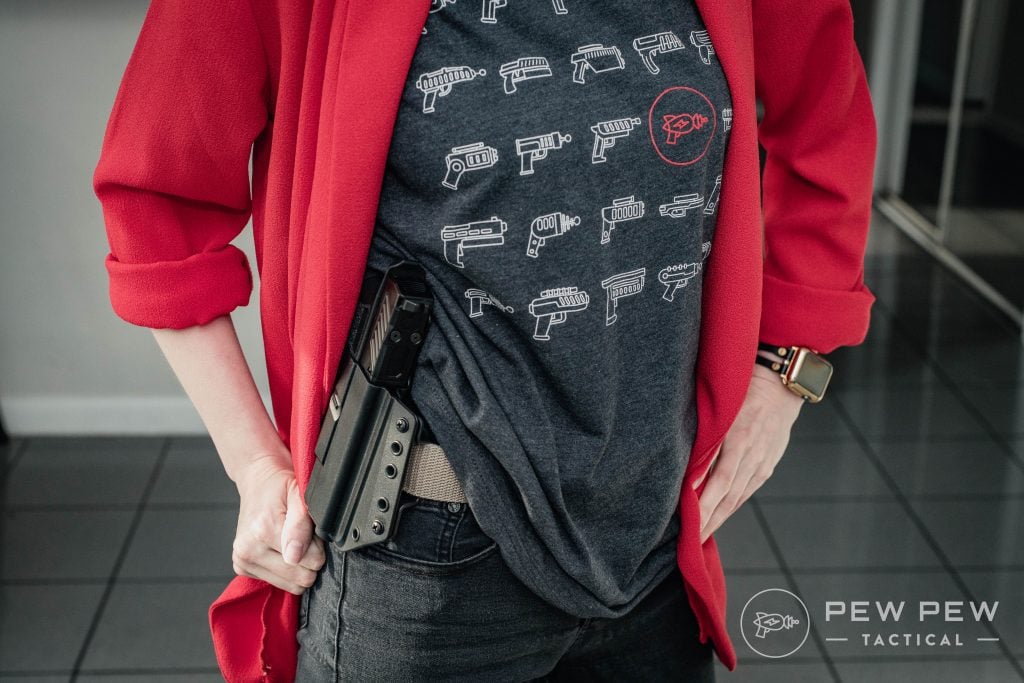
In the case of an overshirt or jacket, you’ll need to sweep the garment out of the way with the dominant hand as you go to retrieve the gun from the holster.
I tend to pin my weak hand to my chest as I do this to keep it out of the way but at the ready.
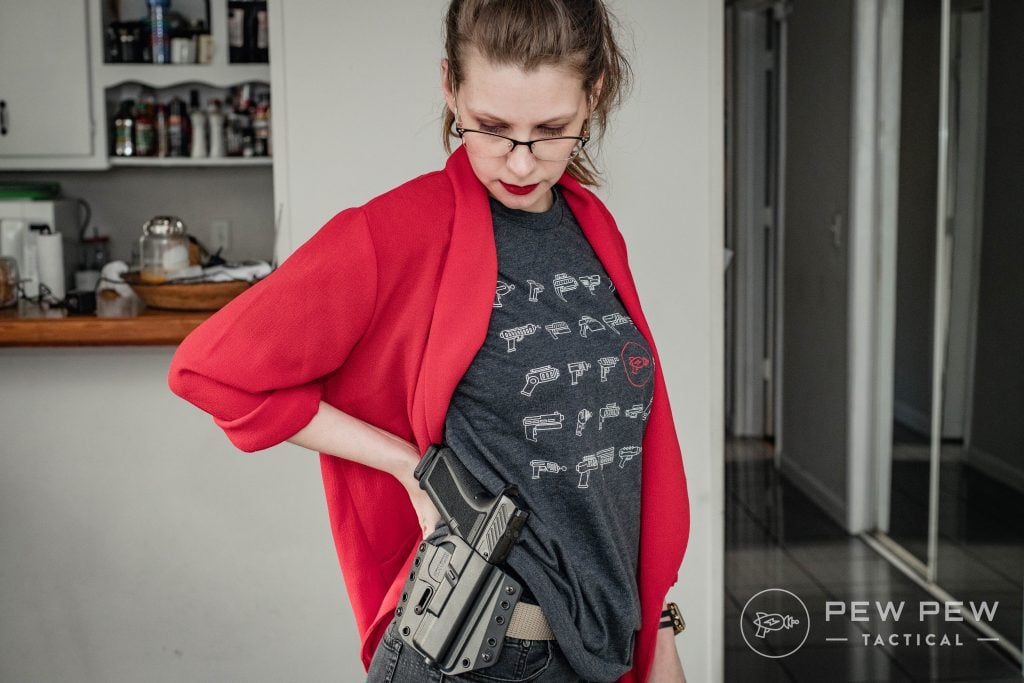
Pull the gun up and out of the holster, then as you press forward, your weak hand will join the party in a regular firing grip.
For a sweatshirt, t-shirt, or blouse, you’ll need to clear the garment out of the way of the gun. The movement is similar to IWB.
To do so, grab the fabric with your weak hand and pull it up and away from the holster.
I prefer to grab my shirt and forcefully pin my hand to my upper chest to prevent the gun from getting tangled in my shirt. This also keeps my weak arm out of the way of my gun.
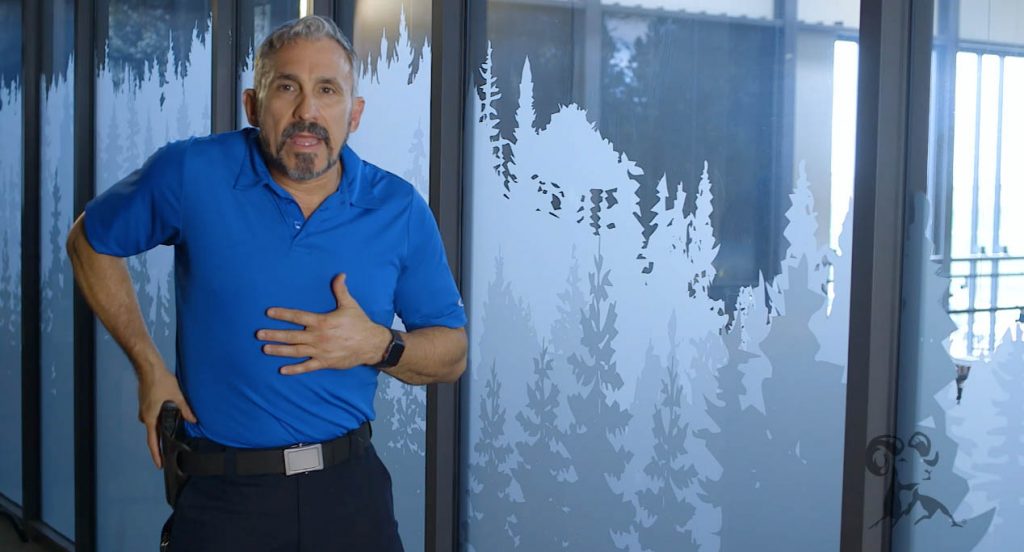
From here, as I push forward, I let go of the shirt, and my weak hand comes to meet my right hand in my firing grip as I press out.
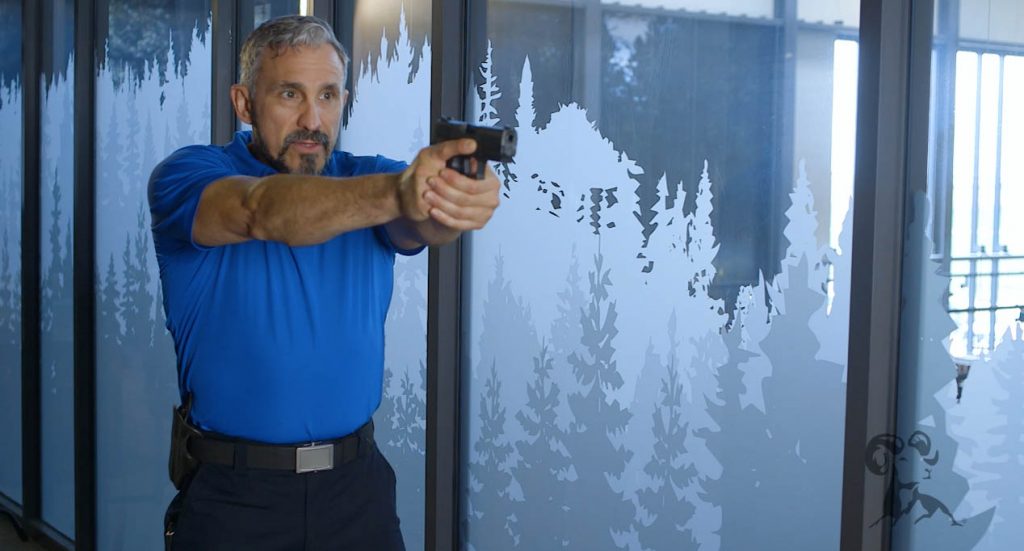
I work in reverse to reholster, using my weak hand to pin my shirt to my chest as I look the gun into the holster. (That’s a fancy way of saying, I watch my gun go back into the holster.)
If you’re like me and prefer more visual help with this, check out Brownells’ Daily Defense video below. Jeff Gonzales does a fantastic job of illustrating how to draw from an OWB holster.
Drawing from an IWB Holster
Drawing from an IWB holster is similar to drawing from an OWB under a shirt/sweatshirt. But, of course, the gun is on the inside of your pants versus the outside.
For this, you’re most likely going to be wearing a t-shirt, blouse, or something similar.
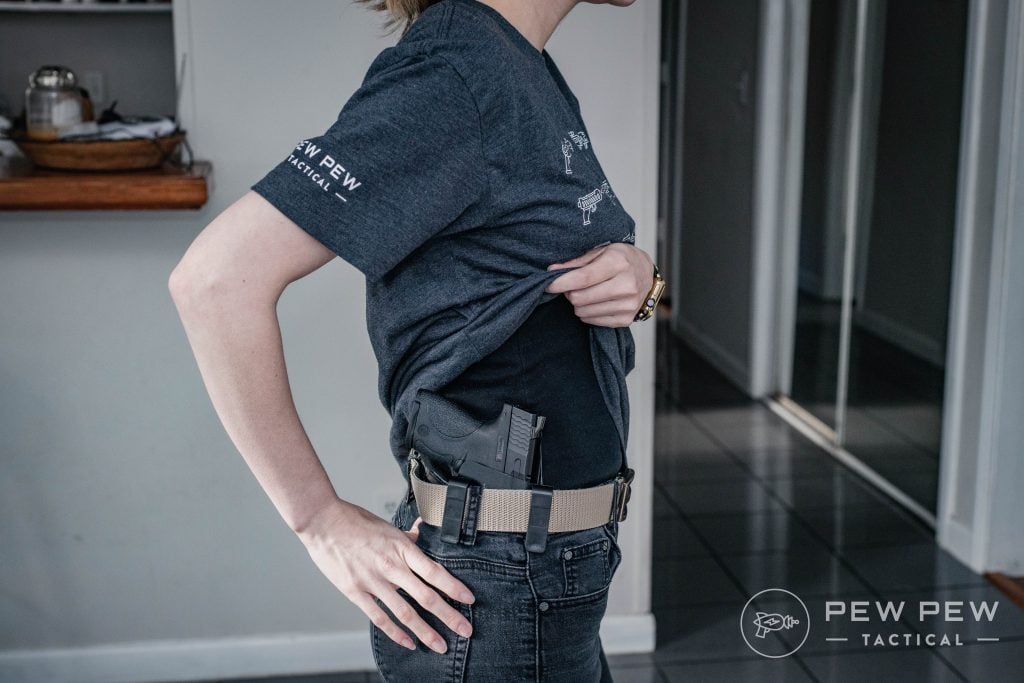
To draw the firearm, grab your shirt with the non-dominant hand, pulling up and away from the gun.
Again, I prefer to keep my hand to my chest to give myself plenty of clearance.
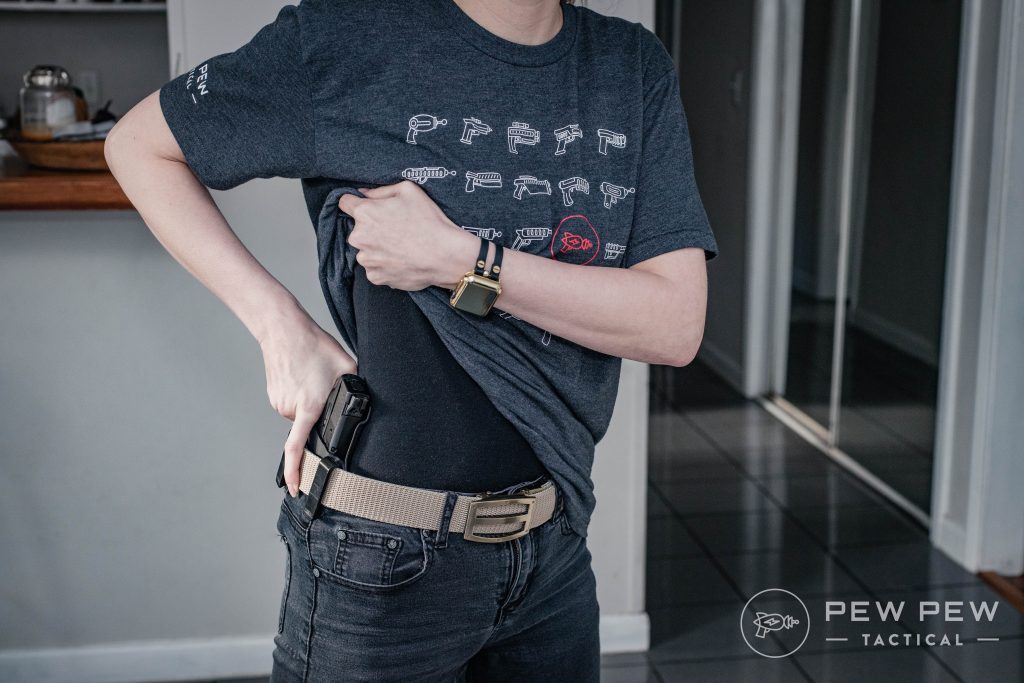
Remove the gun from the holster by pulling up, and then as you press out towards the target, your weak hand can drop the shirt and meet your dominant hand in a firing grip.
To reholster, reverse the previous order. Remove your weak hand from the gun, pull your shirt up and away, then look your gun back into the holster.
To get a better idea of how to draw from IWB, check out Brownells’ Daily Defense video demonstrating the technique.
Additional Things to Practice
Keep in mind that you won’t always have both hands free when you need to draw your gun.
You might be loading groceries in your car, playing on your phone at the gas pump, sitting at a stoplight in your car, or have an umbrella in your hand.
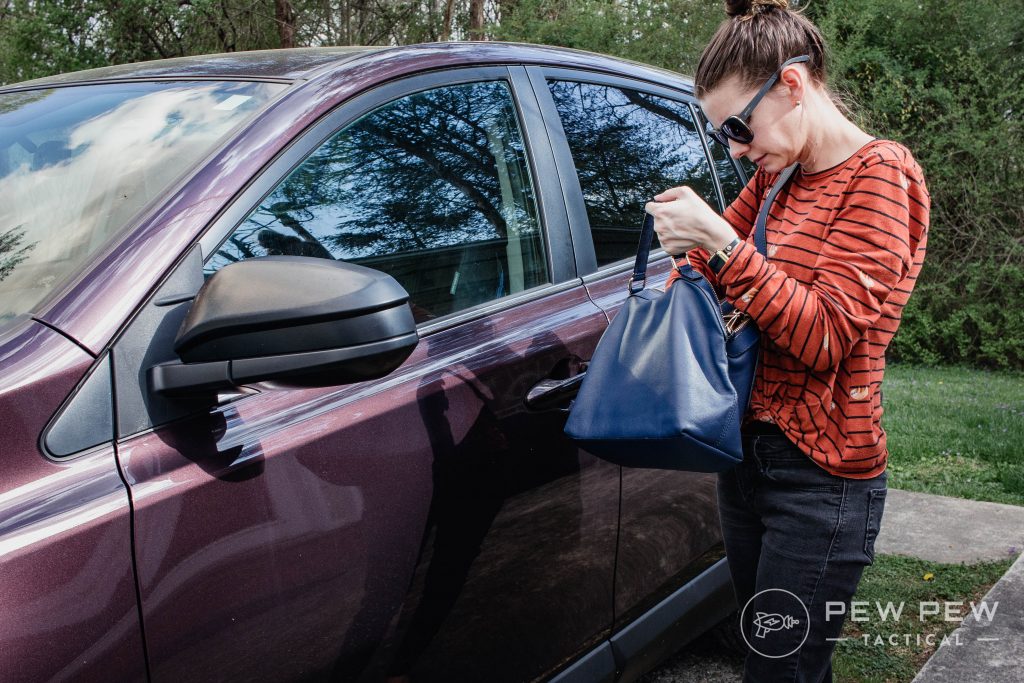
How do you know how to handle these situations?
Practice!
Fill up some paper bags with something to simulate groceries and practice dropping or tossing the bag and drawing your gun.
Take a course or consider how you would react if you had your kids with you.
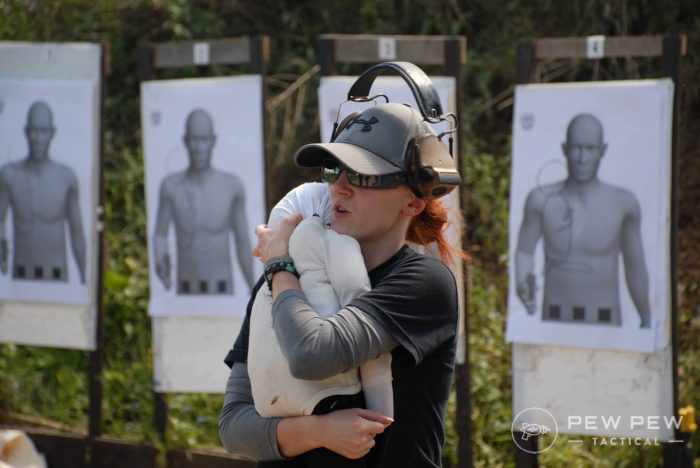
Thinking through possible scenarios then practicing for them will make you better prepared.
Conclusion
While training may feel like a huge hassle, it’s an essential part of being a responsible concealed carrying gun owner.
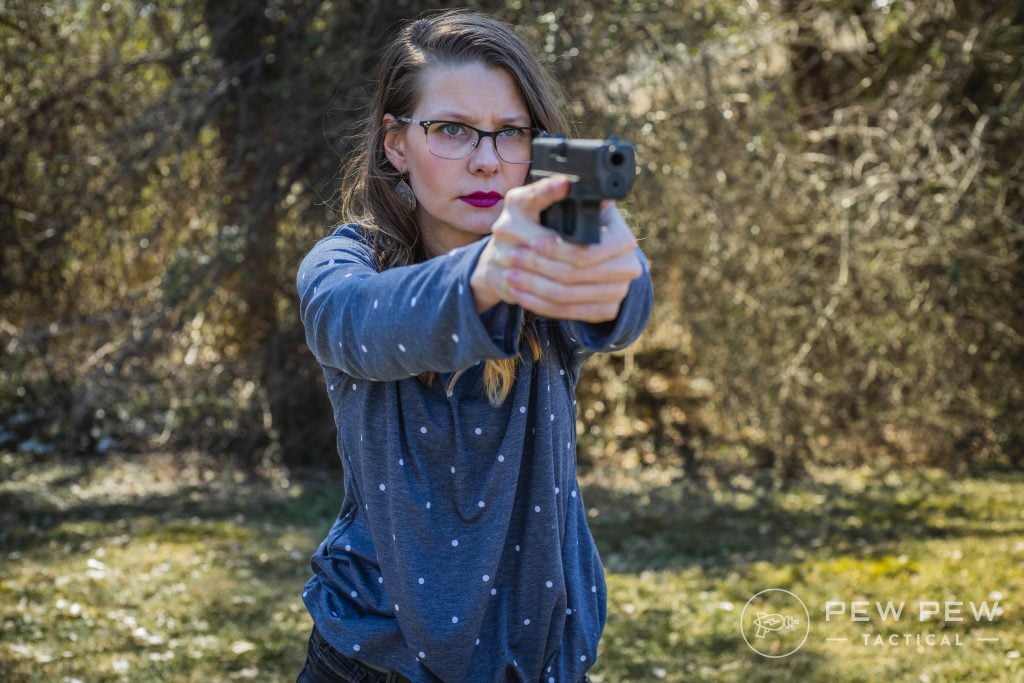
Aside from the obvious benefits of improving your skills and comfort, it also boosts your confidence.
All of this comes together to allow you to make better decisions and react accordingly should you ever encounter an SHTF type of situation.
In short, it’s worth 10 minutes out of your day to practice your concealed carry draw.
How often do you practice your draw? Let us know in the comments below! For more concealed carry content, make sure to check out the section dedicated entirely to all things Concealed Carry!

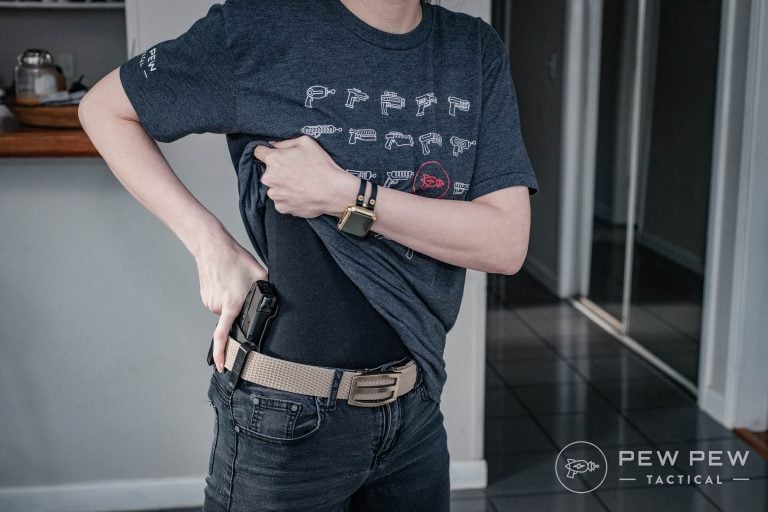







6 Leave a Reply
I practice a lot from concealment with several types of holsters. But when I try to draw fast the gun always seems to be canted slightly to the left. Consequently, I must compensate by aiming right. How do I fix this problem?
You can get at least 1 practice draw in every day. At the end of the day, when it's time to take your gun off, instead of just taking your gun out of the holster, get in a practice draw.
Don't do this! Assuming you are carrying loaded, you are just asking for a negligent discharge.
NO! NO! NO! Never never never ever practice draw with a weapon with live ammo.
One day, after practicing my draw, it occurred to me how important it is to keep my right (strong-side) hand free and I started carrying groceries and umbrellas with my left hand whenever possible. I've done this long enough that it is second nature This allows my right hand to always be free should I need to draw my weapon.
I disagree, if you carry concealed you have to clear/sweep your cover garment before you can begin your actual draw so keeping your weak side free has always